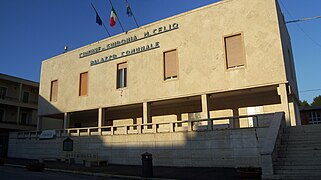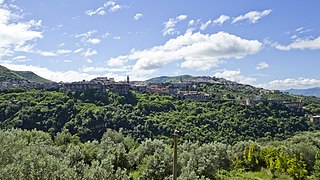| Metropolitan City of Rome Capital Città metropolitana di Roma Capitale (Italian) | |
|---|---|
| Metropolitan city | |
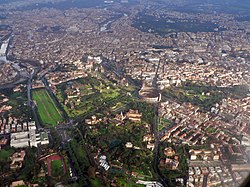 Aerial view of Rome Aerial view of Rome | |
 Flag Flag Coat of arms Coat of arms | |
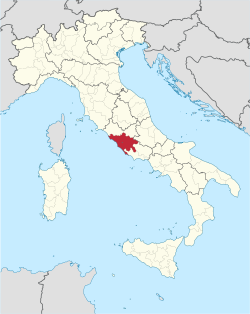 Location of the Metropolitan City of Rome Capital Location of the Metropolitan City of Rome Capital | |
| Coordinates: 41°53′35″N 12°28′58″E / 41.89306°N 12.48278°E / 41.89306; 12.48278 | |
| Country | |
| Region | Lazio |
| Established | 1 January 2015 |
| Capital(s) | Rome |
| Comuni | 121 |
| Government | |
| • Metropolitan Mayor | Roberto Gualtieri (PD) |
| Area | |
| • Total | 5,363 km (2,071 sq mi) |
| Population | |
| • Total | 4,214,463 |
| • Density | 812/km (2,100/sq mi) |
| GDP | |
| • Metro | €163.462 billion |
| Time zone | UTC+1 (CET) |
| • Summer (DST) | UTC+2 (CEST) |
| ISO 3166 code | IT-RM |
| ISTAT | 258 |
| Website | cittametropolitanaroma.gov.it |
Metropolitan City of Rome Capital (Italian: città metropolitana di Roma Capitale) is an area of local government at the level of metropolitan city in the Lazio region of Italy. It comprises the territory of the city of Rome and 120 other comuni (sg.: comune) in the hinterland of the city. With more than 4.3 million inhabitants, it is the largest metropolitan city in Italy.
| Year | Pop. | ±% |
|---|---|---|
| 1951 | 2,150,670 | — |
| 1961 | 2,775,380 | +29.0% |
| 1971 | 3,490,377 | +25.8% |
| 1981 | 3,695,961 | +5.9% |
| 1991 | 3,761,067 | +1.8% |
| 2001 | 3,700,424 | −1.6% |
| 2011 | 3,997,465 | +8.0% |
| 2021 | 4,216,874 | +5.5% |
| Source: ISTAT | ||
It was established on 1 January 2015 by the terms of Law 142/1990 (Reform of local authorities) and by Law 56/2014. It superseded the province of Rome. The Metropolitan City of Rome Capital is headed by the Metropolitan Mayor (Sindaco metropolitano) and governed by the Metropolitan Council (Consiglio metropolitano). Roberto Gualtieri is the incumbent mayor, having taken office on 21 October 2021.
Geography
The Metropolitan City of Rome Capital covers almost one-third of the territory of Lazio. It occupies the flat area of the Roman and the Tiber Valley to the mountains and dell'Aniene Lucretili Sabini and, in addition to the mountainous regions of the Tolfa and Monti Sabatini to the north-west, the area of the mountains Tiburtini Prenestini Simbruini and east, the area of the Colli Albani and the northern foothills of the mountains, and high Lepine Sacco valley to the south-east. The western boundary of the province is represented by the Tyrrhenian Sea on which spread to about 130 kilometres (81 mi) from the coast near Rome from Civitavecchia to Torre Astura. In the territory there are several lakes, almost all of volcanic origin, which are concentrated in the north-west of the mountains and Sabatini in the south-east of the Colli Albani.
Government
Metropolitan Council
The new Metro municipalities, giving large urban areas the administrative powers of a province, are conceived for improving the performance of local administrations and to slash local spending by better coordinating the municipalities in providing basic services (including transport, school and social programs) and environment protection. In this policy framework, the Mayor of Rome is designated to exercise the functions of Metropolitan mayor, presiding over a Metropolitan Council. The Council consists of mayors and city councillors of each comune in the Metropolitan City elected from amongst themselves using partially open list proportional representation, with seats allocated using the D'Hondt method. Metropolitan councillors are elected at-large for five-year terms; votes for metropolitan councillors are weighted by grouping comunes of a certain population range into nine groups so that votes of the mayors and city councillors of the more populous groups are worth than those of less populous groups.
The Metropolitan Council of the city was elected on 20 December 2021:
| Group | Seats | |
|---|---|---|
| Centre-left coalition (PD • A • IV) |
14 / 24 | |
| Right-wing coalition (FdI • L) |
8 / 24 | |
| Five Star Movement (M5S) | 2 / 24 | |
List of Metropolitan Mayors of Rome
| Metropolitan Mayor | Term start | Term end | Party | |
|---|---|---|---|---|
| 1 | Ignazio Marino | 1 January 2015 | 31 October 2015 | PD |
| Special commissioner (31 October 2015 – 22 June 2016) | ||||
| 2 | Virginia Raggi | 22 June 2016 | 21 October 2021 | M5S |
| 3 | Roberto Gualtieri | 21 October 2021 | Incumbent | PD |
Administrative divisions
Main article: List of communes of the Metropolitan City of Capital RomeThere are 121 comunes of Metropolitan City of Rome Capital. The comunes with the largest populations are listed below.


| Rank | City | Population | Area (km) |
Density (inhabitants/km) |
Altitude (mslm) |
|---|---|---|---|---|---|
| 1st | Rome | 2,745,777 | 1,287.36 | 2132.9 | 21 |
| 2nd | Guidonia Montecelio | 89,112 | 79.47 | 1121.3 | 105 |
| 3rd | Fiumicino | 81,980 | 213.89 | 382.9 | 1 |
| 4th | Pomezia | 64,268 | 86.57 | 742.4 | 108 |
| 5th | Anzio | 58,936 | 43.65 | 1350.2 | 3 |
| 6th | Tivoli | 54,914 | 68.65 | 799.9 | 235 |
| 7th | Velletri | 52,543 | 118.23 | 444.4 | 332 |
| 8th | Civitavecchia | 51,691 | 73.74 | 701 | 10 |
| 9th | Ardea | 49,329 | 72.09 | 684.3 | 37 |
| 10th | Nettuno | 47,896 | 71.64 | 668.6 | 11 |
| 11th | Marino | 46,539 | 24.19 | 1923.9 | 360 |
| 12th | Monterotondo | 41,016 | 40.94 | 1003.8 | 165 |
| 13th | Ladispoli | 40,631 | 25.95 | 1565.7 | 2 |
| 14th | Albano Laziale | 39,620 | 23.80 | 1664.7 | 400 |
| 15th | Ciampino | 38,696 | 13.00 | 2976.6 | 124 |
Municipal government
Here is a list of the municipal government in cities and towns with more than 15,000 inhabitants:
| Municipality | Mayor | Party | Executive | Term | |
|---|---|---|---|---|---|
| Rome | Roberto Gualtieri | PD | PD • EV • SI | 2021–2026 | |
| Guidonia Montecelio | Mauro Lomabrdo | Ind | Ind | 2022–2027 | |
| Fiumicino | Mario Baccini | Ind | FI • L • FdI • UDC | 2023–2028 | |
| Pomezia | Veronica Felici | Ind | FI • L • FdI | 2023–2028 | |
| Anzio | Special Commissioner (since 2022) | ||||
| Tivoli | Marco Innocenzi | FdI | FI • L • FdI | 2024–2029 | |
| Velletri | Ascanio Cascella | FdI | FI • L • FdI | 2023–2028 | |
| Civitavecchia | Marco Piendibene | PD | PD • M5S • AVS | 2024–2029 | |
| Ardea | Maurizio Cremonini | FdI | FI • L • FdI | 2022–2027 | |
| Nettuno | Special Commissioner (since 2022) | ||||
| Marino | Stefano Cecchi | Ind | FI • L | 2021–2026 | |
| Monterotondo | Riccardo Varone | PD | PD • AVS | 2024–2029 | |
| Ladispoli | Alessandro Grando | Ind | FI • L • FdI | 2022–2027 | |
| Albano Laziale | Massimo Borelli | PD | PD • Ind | 2020–2025 | |
| Ciampino | Emanuele Colella | PD | PD • Ind | 2022–2027 | |
Transport
Main article: Transport in Rome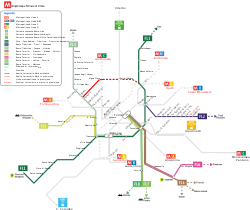
The Metropolitan City of Rome Capital is the centre of a radial network of roads that roughly follow the lines of the ancient Roman roads which began at the Capitoline Hill and connected Rome with its empire. Today Rome is circled, at a distance of about 10 km (6 mi) from the Capitol, by the ring-road (the Grande Raccordo Anulare or GRA).
Due to its location in the centre of the Italian peninsula, Rome is the principal railway node for central Italy. Rome's main railway station, Termini, is one of the largest railway stations in Europe and the most heavily used in Italy, with around 400 thousand travellers passing through every day. The second-largest station in the city, Roma Tiburtina, has been redeveloped as a high-speed rail terminus.
Rome is served by three airports. The intercontinental Leonardo da Vinci International Airport is Italy's chief airport, is located within the nearby Fiumicino, south-west of Rome. The older Rome Ciampino Airport is a joint civilian and military airport. It is commonly referred to as "Ciampino Airport", as it is located beside Ciampino, south-east of Rome. A third airport, the Rome Urbe Airport, is a small, low-traffic airport located about 6 km (4 mi) north of the city centre, which handles most helicopter and private flights.
The city has its own quarter on the Mediterranean Sea (Lido di Ostia), equipped with a tourist port and a small channel-harbour for fisher boats. The main harbour which serves Rome is the Port of Civitavecchia, located about 62 km (39 mi) northwest of the city, part of the "Motorways of the Sea", it is linked to several Mediterranean ports and is one of the busiest cruise ports in the world.
A 3-line metro system called the Metropolitana operates in the Metropolitan City of Rome. Construction on the first branch started in the 1930s. The line had been planned to quickly connect the main railway station with the newly planned E42 area in the southern suburbs, where the 1942 World Fair was supposed to be held. The event never took place because of war, but the area was later partly redesigned and renamed EUR (Esposizione Universale di Roma: Rome Universal Exhibition) in the 1950s to serve as a modern business district. The line was finally opened in 1955, and it is now the south part of the B Line.
The A line opened in 1980 from Ottaviano to Anagnina stations, later extended in stages (1999–2000) to Battistini. In the 1990s, an extension of the B line was opened from Termini to Rebibbia. This underground network is generally reliable (although it may become very congested at peak times and during events, especially the A line) as it is relatively short.
The A and B lines intersect at Roma Termini station. A new branch of the B line (B1) opened on 13 June 2012 after an estimated building cost of €500 million. B1 connects to line B at Piazza Bologna and has four stations over a distance of 3.9 km (2 mi).
A third line, the C line, is under construction with an estimated cost of €3 billion and will have 30 stations over a distance of 25.5 km (16 mi). It will partly replace the existing Termini-Pantano rail line. It will feature full automated, driverless trains. The first section with 15 stations connecting Pantano with the quarter of Centocelle in the eastern part of the city, opened on 9 November 2014. The end of the work was scheduled in 2015, but archaeological findings often delay underground construction work.
A fourth line, D line, is also planned. It will have 22 stations over a distance of 20 km (12 mi).
Gallery
See also
References
- "Roma in cifre. 2017" (PDF). Roma. Retrieved 3 October 2018.
- "Gross domestic product (GDP) at current market prices by metropolitan regions". ec.europa.eu.
- "Codici delle città metropolitane al 1° gennaio 2017". www.istat.it (in Italian). 23 December 2016.
- Vittorio Ferri (2009). "Metropolitan cities in Italy. An institution of federalism" (PDF). University of Milan-Bicocca. Retrieved 23 May 2011.
{{cite journal}}: Cite journal requires|journal=(help) - ^ "LEGGE 7 aprile 2014, n. 56" (PDF). ponmetro.it/. Pon Metro. Retrieved 13 August 2019.
- – Entry on Roma Tiburtina station on the official website of the Italian high-speed rail service (in Italian)
- "Porti di Roma". Retrieved 6 March 2015.
- Kington, Tom (14 May 2007). "Roman remains threaten metro". Guardian. London. Retrieved 10 August 2008.
- "Metro C, apre la Pantano-Centocelle: folla di romani all'inaugurazione". Il Messaggero (in Italian). 9 November 2014. Retrieved 11 November 2014.
External links
| Metropolitan cities and areas of Italy | |
|---|---|
| Metropolitan cities | |
| Metropolitan areas | |
| Provinces and places |  | |
|---|---|---|
| History |
| |
| Lakes | ||
| Mountains |
| |
| Geography | ||
| Politics | ||
| Culture | ||
| Categories | ||
